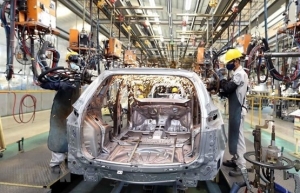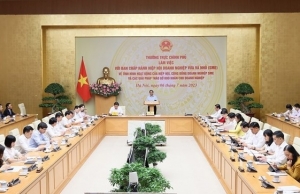Nation sticks to its guns over economic growth goals
Prime Minister Pham Minh Chinh last week required authorities at all levels to “place the biggest priority on successfully achieving the set target of 6.5 per cent economic growth this year.”
“We have no plan to revise the growth goal of 6.5 per cent for 2023. Despite lower-than-expected economic growth in the first six months, all efforts must be made to hit the set growth target for the entire year,” PM Chinh said at last week’s government meeting on six-month socioeconomic performance with ministries and localities throughout the country.
“To realise the growth goal, we must continue drastically support enterprises, whose performance is bouncing back. The economy has also been gradually recovering.”
He demanded the review of pro-business policies and mechanisms so that “more suitable solutions must be formulated in order to boost all momentum for economic growth – both in supply and demand.”
“There must be stronger and more effective solutions to stimulate demand for consumption and strongly develop the domestic market, such as solutions on exempting and reducing taxes and fees, and support for goods purchase, price reduction, and reduction in banks’ lending rates,” the PM said.
 |
| Input costs and accessing markets remain a challenge for enterprises attempting to make it big elsewhere, photo Le Toan |
After growing 3.32 per cent in Q1, the Vietnamese economy bounced back at 4.14 per cent in Q2. In the first half of the year, it increased 3.72 per cent on-year.
The Ministry of Planning and Investment (MPI) last week reported to the government two fresh economic growth scenarios for the second half of this year and the whole year, based on such a low growth rate for the first half of 2023, which was also the lowest six-month growth rate in 2011-2023, except for the on-year expansion of merely 1.74 per cent in the first half of 2020.
| Tran Quoc Phuong - Deputy Minister of Planning and Investment
The situation from now until the year’s end will continue to be difficult. There will be more difficulties than advantages. It will be quite a tough job for the country to achieve an economic growth rate of 6.5 per cent for the whole year as stipulated by the National Assembly (NA). The Ministry of Planning and Investment (MPI) has proposed a group of policy solutions. At the same time, based on the results of 27 government delegations to work with localities recently, the MPI has also drafted a special resolution for the last six months of the year: on ensuring macroeconomic stability to promote growth, strengthen discipline, and boost administrative reform. It has been submitted to the government and all relevant authorities for consultation. The MPI will gather all feedback and finalise the draft resolution to submit to the government for consideration. This is also a resolution focusing on many solutions to achieve the goal of economic growth and ensure social security from now until the end of the year. On that basis, I would like to summarise a few main groups of solutions. Firstly, with the perception that the world situation is changing very fast and unpredictably, the prime minister has placed a major focus on strengthening forecasting analysis activities. Therefore, the MPI has set a number of key tasks for ministries and sectors, especially those related to the international markets, to closely grasp the situation and developments. The second group of solutions is to stick to the government’s direction, which is to maintain macroeconomic stability at all costs. This is the fundamental factor for us to promote economic growth and maintain growth drivers. On such a basis, this group of solutions are focused on continuing to administer goods and fiscal and monetary policies, as well as recommending the State Bank of Vietnam (SBV) continue programmes for improvement on lending rates to provide more capital for the economy. The SBV is also recommended to continue to carry out solutions in fiscal policy related to tax exemption and reduction, and implement the NA’s resolutions on supporting enterprises, including a VAT reduction of 2 per cent. We also know that in this group of solutions, the pressure on inflation from now until the end of the year is decreasing compared to before. In the first half of this year, the consumer price index increased 3.29 per cent on-year. Thus, the country has a lot of room for reining in inflation at 4.5 per cent as set by the NA, and this allows us to focus more on growth. The third focus is to review all growth drivers to spur economic growth. One analysis by the MPI shows that when we remove difficulties, we increase motivation for economic growth. Now we must focus on solving problems for businesses. |
Under the first scenario, the economy will likely grow 6 per cent this year, with 6.8 per cent for Q3 and 9 per cent for Q4, which are 0.3 and 1.9 per cent respectively higher than the initial plan set early this year. The rate must be 8 per cent in the second half of the year.
Under the second scenario, the whole-year growth rate is set to be 6.5 per cent, with 7.4 per cent for Q3 and 10.3 per cent for Q4, which are 0.9 and 3.2 per cent respectively higher than the initial plan set early this year. The rate must be 8.9 per cent in the second half of the year.
“However, we will have to make all best efforts to materialise the set target of 6.5 per cent despite massive difficulties ahead. We must take advantage of all opportunities and policies, and overcome woes to accomplish the growth goal,” said Minister of Planning and Investment Nguyen Chi Dung.
According to the GSO, the first half of this year saw 60,200 businesses with halted operations – up 18.2 per cent on-year; 31,000 enterprises stopped operations and awaited dissolution procedures – up 28.9 per cent; and 8,800 enterprises completed such procedures. On average, about 16,700 businesses were kicked from the market every month.
Minister Dung underlined the main difficulties facing enterprises, including a lack of output markets, difficulty accessing to loans, cumbersome administrative procedures, and a need for a better business and investment environment.
“Input costs and costs for compliance with legal regulations, and costs to access the market are still very high. Enterprises difficulties are directly causing issues with employment, incomes, and livelihoods for labourers,” he said.
“These issues have received special attention from the government which has enacted a series of pro-business policies regarding reduction of lending rates, borrowing conditions, taxes, and fees.”
Prompted by economic woes, the International Monetary Fund also lowered its projection for Vietnam’s growth from 6.2 per cent in January to 4.7 per cent for this year. This, however, will still be among the highest in the Emerging and Developing Asia group with 30 economies forecast.
According to the World Bank, one of the biggest drivers for economic growth in Vietnam is to boost public investment. “Acceleration of public disbursement could support aggregate demand and economic growth in the short run while ensuring investments in human capital and resilient and green infrastructure will bolster long term economic development,” the bank said.
Vietnam’s GDP last year grew 8.02 per cent, the highest level over the past 10 years. Total per capita income hit $4,110.
 | Government teleconference with localities: tasks for remaining months heavy At the Government's teleconference with localities and the regular Cabinet meeting in Hanoi on July 4, the Ministry of Planning and Investment (MoPI) presented two growth scenarios for the third quarter and the whole year 2023, indicating that the tasks for the remaining months of this year are heavy, with a growth rate of 8.0 per cent or higher. |
 | Government, SMEs work to seek ways for navigating challenges Prime Minister Pham Minh Chinh chaired a meeting between permanent Government members and the executive committee of the Vietnam Association of Small and Medium Enterprises (SMEs) in Hanoi on July 6 to seek solutions to challenges facing SMEs. |
What the stars mean:
★ Poor ★ ★ Promising ★★★ Good ★★★★ Very good ★★★★★ Exceptional
Related Contents
Latest News
More News
- Dat Bike accelerates sustainable mobility (January 07, 2026 | 15:24)
- Innovation to support modern healthcare development (January 07, 2026 | 10:00)
- Six localities record double-digit growth as regional performance diverges in 2025 (January 06, 2026 | 18:00)
- E-commerce market undergoes transformation amid rising competition and regulation (January 06, 2026 | 17:54)
- Vietnam’s industrial output hits seven-year high in 2025 (January 06, 2026 | 17:47)
- GELEX’s credit rating outlook upgraded to 'Positive' by VIS Rating (January 06, 2026 | 16:49)
- Finance sector lays firm groundwork for 2026 after major reform (January 06, 2026 | 15:30)
- Vietnam’s seafood exports surpass $11 billion in 2025 (January 06, 2026 | 08:51)
- Vietnam GDP posts second-strongest growth since 2011 (January 06, 2026 | 08:35)
- Double-digit GDP growth within reach with shift to higher-value expansion (January 06, 2026 | 08:33)


 Tag:
Tag:




















 Mobile Version
Mobile Version